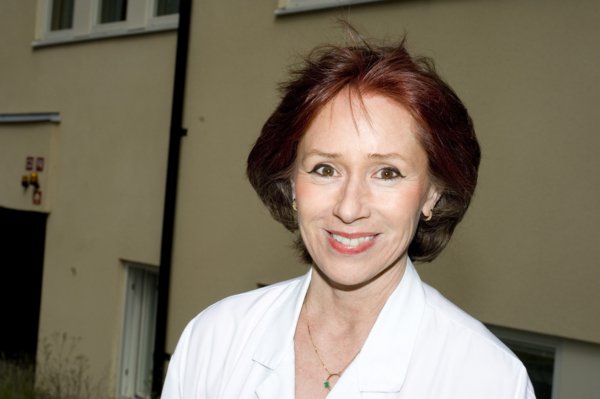How menstruation affects women's health
At best it’s only messy. At worst, it's a greatly limiting factor, where severe pain or heavy bleeding puts restrictions on your work and social life. We have talked to researchers about how menstruation affects women's health.

Text Annika Lund, first published in Medicinsk Vetenskap 4, 2016.
Are your female colleagues usually off sick from work with menstrual pain or heavy bleeding? Perhaps you're not aware of this? No, probably not. But there is no doubt that it happens.
Among other things, this is revealed in a study conducted by Lena Marions, gynaecologist and researcher at Karolinska Institutet's Department of Clinical Research and Education at Södersjukhuset (Stockholm South General Hospital). She and colleagues have asked more than 1,500 women aged 40 to 45 about their period. About one third say they have heavy bleeding. In a clinical context, this refers to bleeding that exceeds 80 ml per menstrual period, a measurement which is admittedly difficult to keep track of. A more practical measurement, and the one used in the study, is to ask the woman if their sanitary protection bleeds through, it if has to be changed at night and if the discharge is lumpy in parts.
Women who bleed a lot describe a reduced quality of life, where almost a quarter refrain from social activities because of bleeding, according to the study. Over 90 per cent of these women find the bleeding to be bothersome and a higher percentage feel shabby. Furthermore, 16 per cent of the women with heavy bleeding report that they are off sick from work due to this, some providing figures between six and ten days per year.

“We need increased awareness that many women are adversely affected by their period. There is a need to change our current perceptions of this matter,” says Lena Marions.
Even women who describe their bleeding as “normal” are affected, which was about 40 per cent of the study participants. Of these, about two per cent refrain from social activities and as many are home from work for up to five days per year because of the bleeding. Nearly eight out of ten women with normal bleeding find their period to be bothersome and even more find it makes them feel shabby.
But only one in four women with heavily bleeding have sought care for this.
“Women who bleed a lot during menstruation are a heterogeneous group, where there can be many causes behind the bleeding. There is a hereditary factor that might get some women to think ‘this has always been the way for women in my family’, and so they think maybe that it has to be this way. But it is important to find out the cause and there are treatments available,” says Lena Marions.
Increased bleeding tendency
For example, a coagulation disorder may be the underlying cause. In that case, the woman has a general increased bleeding tendency that should be investigated further. Patients who take the anticoagulant warfarin or aspirin also bleed more easily. Heavy bleeding can also be caused by fibroids, nodules of muscles and connective tissue in the uterus. The nodes make the uterine surface uneven, resulting in the uterine lining having a larger area. This means that more vessels grow in the mucous membrane and therefore there are more vessels torn when the lining is expelled – that is to say, there are more vessels that bleed.
Besides messiness and practical problems, heavy bleeding can result in an iron deficiency. This in turn causes great fatigue.
Lena Marions has just started a new study. The study will involve 17-year-old girls describing their period and answering related questions, such as to what extent the bleeding results in them staying home from school.
“This is a very relevant question. We know it happens, but not to what extent. On the whole, there is limited research on how women are actually affected by their period,” says Lena Marions.
There are treatments available for those who want to bleed less. For example, you can insert a hormonal intrauterine device, which greatly reduces bleeding, or use a contraceptive pill. This can be done in two ways: you either choose a pill that only contains the hormone gestagen, which means that there will be no bleeding. Or you can “merge the packages” of regular contraceptive pills, i.e., skip over the break between the packages, which also means that there will be no bleeding. Today, there are studies that show that it is safe to take the pill in this way.
There are also over-the-counter medications that improve blood clotting, resulting in less bleeding from the ulcerated area under the expelled lining.
However, for those who are not helped by this, or do not want to use the pill, the range of treatments is sparse.
And if you zoom out the perspective, how should these issues actually be viewed? Is it really right to medicate such a normal condition such as menstruation, thereby classifying it as an illness?
“You have to juggle several ideas in your head at the same time here. One aspect involves normalising issues about menstruation and finding out how women are affected by it. There's this idea that if you are adversely affected in your professional or social life, there is always a way to fix it where there's a will. Another aspect is about focusing on the aberrant. This involves finding out more about pathological conditions such as endometriosis and PCOS,” says Lena Marions.
Today, between 10 and 15 per cent get the disease endometriosis, which occurs when cells from the uterine lining end up in the wrong places in the body, for example, behind the uterus, on the fallopian tubes, on the intestines or by scars from surgeries in the abdomen. The misplaced lining forms a very painful inflammation centre, especially during menstruation. Period pains can be so severe that they cause fainting and they can also be chronic, so that it hurts all the time, even between bleeds. Pain during intercourse felt deep in the vagina is also associated with this disease.
Focusing on endometriosis
One individual focusing their research on endometriosis is Sebastian Gidlöf, gynaecologist and researcher at the Department of Women's and Children's Health and the Department of Clinical Science, Intervention and Technology at Karolinska Institutet. He describes the difficulties of researching within an area where there are no good animal models – it is basically just people, some monkeys, the elephant shrew and one species of bat that menstruate.
“Research on women's health is generally neglected and it’s more difficult to find funding. But with endometriosis, research is also limited by the difficulties with using a reliable animal model,” he says.
There is therefore a lack of basic knowledge, such as how the disease occurs. One explanatory model asserts that the woman “bleeds backwards” during menstruation so that the blood is squeezed out through the fallopian tubes, allowing the accompanying cells from the uterine lining to attach to the wrong places. But as almost all women experience such backward bleeding during menstruation, something more is required for the disease to develop, but this is not yet known.
The disease seems to have become more common. One reason may be that women today have more menstrual periods than they have had in the past. Before, the average woman got her first period later than is the case today, due to poor nutrition. She probably became pregnant pretty soon after to then go on to give birth and nurse many children in quick succession, resulting in long menstrual interruptions.
This is in stark contrast to today, when the average girl gets her first period at just under 13 years of age. She then bleeds around twelve times per year up until menopause – hundreds of times over a lifetime.
“One can imagine that many menstruations, had by women today, involve more backward bleeding and more occasions for the disease to become established,” says Sebastian Gidlöf.
He is interested in the immune system's role in this context, especially the so-called NK cells, “natural killer cells”, which normally have the task of destroying cancer cells and viruses, among other threats.
However, in the uterus in particular, the NK cells have another task. There they prevent the mother's immune system from attacking the embryo, which is nestled in the uterine lining. Sebastian Gidlöf wants to investigate whether the NK cells during endometriosis are too effective in this protective role, so that they also protect the uterine lining which is on the loose in the body.
In a pilot study, he compared NK cells in menstrual blood collected via a menstrual cup with normal blood from the same women. He identified differences in what receptors the NK cells expressed, that is to say, how they worked, and the pattern was stable over several menstrual cycles. The researchers conclude that blood collected via a menstrual cup reveals the immune activity in the uterus and is a method for studying the disease.
Now Sebastian Gidlöf plans to examine more women, both with and without endometriosis. If it should be revealed that something relating to the NK cells differs significantly in women with endometriosis, then this could potentially, in a best-case scenario, answer basic questions concerning the origin of the disease.
“Eventually it may also be possible to make the diagnosis by examining the content of a menstrual cup. That would be a great relief compared to today, where minimally invasive surgery is required to see the endometriosis and establish a reliable diagnosis,” says Sebastian Gidlöf.
Younger women
Endometriosis causes a substantial burden, both for the individual and for society, because it is younger women of childbearing and working age who suffer. For women, this means, in addition to suffering, both sickness absence and reduced income. For society, this means an economic burden comparable to that of other chronic diseases, such as rheumatoid arthritis, Crohn's disease or diabetes, mostly because of women's reduced working capacity.
Sometimes surgical procedures are performed to remove focal areas of endometriosis, but first less radical measures are considered. These include contraceptive pill treatment to completely remove the period, or a hormonal intrauterine device – it is thus partly the same strategy as with heavy bleeding.
This strategy, to take away the period, is also used to help women who bleed rarely or not at all, which is not healthy, because the remnant lining increases the risk of cell changes in the uterus. If you take away the period, no lining is developed and thus no remnant.

There are several reasons a woman may not get her period. The most common is PCOS, polycystic ovary syndrome, which is something that roughly ten per cent of women of menstruating age have. With PCOS, one or both ovaries form more vesicular ovarian follicles than normal. At the same time, it stimulates the ovaries to secrete more of the male hormone testosterone. Women with PCOS therefore have higher levels of testosterone and find it easier to strengthen muscle and bone mass.
This is a great advantage in sport.
Angelica Lindén Hirschberg, gynaecologist and professor at the Department of Women’s and Children's Health at Karolinska Institutet, has shown that women with PCOS are over-represented in sport.
“There are advantages to being easily able to build muscle and bone. These women will probably never need to worry about osteoporosis as they get older,” she says.
Physical performance ability
Angelica Lindén Hirschberg and her colleagues have also studied how women with regular and “normal” periods are affected in their physical performance ability during the menstrual cycle. Their studies provide some evidence that women have slightly improved coordination just before ovulation. There is stronger support for a deterioration in balance just before menstruation, a result that is perhaps confirmed by other studies which show that the risk of injury associated with sports is possibly higher at this stage of the cycle.
They have not been able to identify any difference in muscle strength during the menstrual cycle.
And this too is complicated practical research, explains Angelica Lindén Hirschberg:
“The difficulty is having control of the menstrual cycle of all study participants. It requires frequent measurements of hormones through blood and urine samples. Everyone involved in this knows that you can suddenly be faced with one or more study participants not ovulating at all in the examined cycle. Then you have to start everything again in a new cycle.
Therefore, many studies within the field have few participants, making it difficult to draw clear conclusions.
One of the most studied phases of the menstrual cycle is the premenstrual phase, the period just before menstruation. During this phase, women can experience headaches, swelling and weight gain. Even the psyche can be affected, influencing the individual's mood and causing feelings of dejection or irritability.
This is a fairly well-known symptom that is attributed to progesterone, which rises before menstruation and is converted to allopregnanolone, something that can affect the brain.
But there is a whole range of hormones involved in the cycle’s progression, such as prolactin, LH hormone and FSH hormone. When the levels shift, this affects a number of functions.
For example, women with asthma have an increased risk of asthma attacks in conjunction with menstruation. The risk of this asthma attack being difficult to control and being a more severe episode is also higher during menstruation. How this all fits together has not really been investigated, but Anna-Lena Hulting, Professor of Neuroendocrinology at the Department of Molecular Medicine and Surgery at Karolinska Institutet, was one of those who demonstrated in the 1980s that LH hormone, which is secreted from the pituitary gland in order to get other glands to produce oestrogen for example, also affects the production of leukotrienes, which has to do with asthma.
“If you view it from an overall perspective, the brain is involved in very many processes in the body. From a purely theoretical standpoint, the menstrual cycle fluctuations have an impact on a large number of areas, such as the immune system. Personally, I would find it very exciting to examine whether sensitivity to catching a cold or the flu is affected during the cycle,” says Anna-Lena Hulting.
Oestrogen is considered to be a hormone that increases well-being. It is connected to improved stress management and possibly even better memory functions. The levels of oestrogen are highest just before ovulation, so it can be said somewhat incisively that it is at this time that women exhibit peak mental form.
Anna-Lena Hulting highlights a study in which women were subjected to a stressful situation on two occasions; firstly when their oestrogen levels were high and secondly when they were low, as measured with a blood test. The stress consisted of them having to work out especially difficult mathematical problems while at the same time they were criticised for not doing a good job with it. The women were examined during the time using fMRI, a technique for imaging the brain when working. When there were high levels of oestrogen, the women showed higher activity in the hippocampus, which is interpreted as better stress management. When there were low levels, the opposite occurred.
“It would be very interesting to conduct more studies like this, where the brain is examined with imaging technology during different phases of the menstrual cycle. There is a lot left to learn,” says Anna-Lena Hulting.
Learn more
 Photo: Alexander Donka
Photo: Alexander DonkaShould exercise be adapted to a woman’s menstrual cycle?
Many female athletes believe that their performance is affected by their menstrual cycle. Cecilia Fridén, associate professor at the Department of Neurobiology, Care Sciences and Society, Karolinska Institutet, is going to find out whether that is true.
